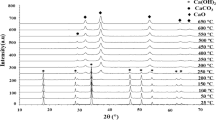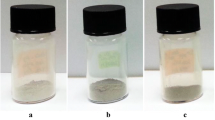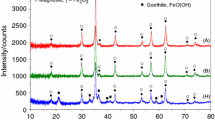Abstract
We report on the homogeneity, structural and luminescence properties of ceria nanoparticles doped with Eu3+. Eu3+ in concentration of 1, 5 and 10 wt% was incorporated via wetness impregnation into preformed ceria nanoparticles followed by calcination in air at 1000 °C. A remarkable homogeneity of Eu3+-ceria solid solutions is measured for ceria grown by citrate and micro-emulsion methods using Raman, Diffuse Reflectance in UV–Vis, photoluminescence spectroscopies and X-ray diffraction, even for the Eu3+ concentration of 10 wt%. The emission properties of all Eu3+-doped ceria samples are well-characterized by a two main centre model assigned to perturbed and isolated Eu3+ centres. These centres correspond to Eu3+ located in the nearest (local symmetry lower than cubic and Eu3+-oxygen coordination lower than eight) and next-nearest-neighbour positions (cubic local symmetry and eightfold Eu3+-oxygen coordination) to oxygen vacancy, respectively. With increase of Eu3+ concentration, both the oxygen vacancy concentration and the relative contribution of the perturbed Eu3+ centre to the total emission increase. It is established that the characteristic emission and excitation spectra of the two main Eu3+ centres as well as the overall multisite distribution of Eu3+ within ceria lattice are intrinsic properties of Eu3+-doped ceria since these do not depend on synthesis route, nanoparticle size and Eu3+ concentration.









Similar content being viewed by others
References
Gerhardt-Anderson R, Nowick AS (1981) Ionic conductivity of CeO2 with trivalent dopants of different ionic radii. Solid State Ionics 5:547–550
Kumar A, Babu S, Karakoti AS, Schulte A, Seal S (2009) Luminescence properties of europium-doped cerium oxide nanoparticles: role of vacancy and oxidation states. Langmuir 25:10998–11007
Sahu T, Singh Bisht S, Ranjan Das K, Kerkar S (2013) Nanoceria: synthesis and biomedical applications. Curr Nanosci 9:588–593
Yan CH, Sun LD, Liao CS, Zhang YX, Lu YQ, Huang HS, Lu SZ (2003) Eu3+ ion as fluorescent probe for detecting the surface effect in nanocrystals. Appl Phys Lett 82:3511–3513
Reisfeld R, Zigansky E, Gaft M (2004) Europium probe for estimation of site symmetry in glass films, glasses and crystals. Mol Phys 102:1319–1330
Fujihara S, Oikawa M (2004) Structure and luminescent properties of CeO2: rare earth (RE = Eu3+ and Sm3+) thin films. J Appl Phys 95:12
Choudhury B, Choudhury A (2012) Lattice distortion and corresponding changes in optical properties of CeO2 nanoparticles on Nd doping. Curr Appl Phys 13:217–223
Liu X, Chen S, Wang S (2007) Synthesis and photoluminescence of CeoO2:Eu3+ phosphor powders. J Lumin 127:650–654
Wang Z, Quan Z, Lin J (2007) Remarkable changes in the optical properties of CeO2 nanocrystals induced by lanthanide ions doping. Inorg Chem 46:5237–5242
Babu S, Schulte A, Seal S (2008) Defects and simmetry influence on visible emission of Eu doped nanoceria. Appl Phys Lett 92:123112
Li L, Yang K, Moon BK, Fu Z, Guo C, Jeong JH, Yi SS, Jang K, Lee HS (2009) Photoluminescence properties of CeO2:Eu3+ nanoparticles synthesized by a sol–gel method. J Phys Chem 113:610–617
Zeng L, Chen D, Cui L, Huang F, Wang Y (2010) High-content bulk doping and thermal stability of rare earth ions in CeO2 nanocrystals. Scipta Materialia 63:661–664
Tiseanu C, Parvulescu VI, Boutonnet M, Cojocaru B, Primus PA, Teodorescu CM, Solans C, Sanchez-Dominguez M (2011) Surface versus volume effects in luminescent ceria nanocrystals synthesized by an oil-in-water micro- emulsion method. Phys Chem Chem Phys 13:17135–17145
Tiseanu C, Parvulescu VI, Sanchez-Dominguez M, Boutonnet M (2012) Temperature induced conversion from surface to “bulk” sites in Eu3+- impregnated CeO2. J Appl Phys 112:013521
Chae KW, Park TR, Cheon CI, Cho NI, Kim JS (2013) Enhanced phasemiscibility and luminescence by inducing oxygen vacancies in Ce1−x Eu x O2- under a strongly reducing atmosphere. J Lumin 136:109–116
Sanchez-Dominguez M, Boutonnet M, Solans C (2009) A novel approach to metal and metal oxide nanoparticle synthesis: the oil-in-water micro- emulsion reaction method. J Nanopart Res 11:1823–1829
Courty P, Ajot H, Marcilly C, Delmon B (1973) Oxydes mixtes ou en solution solide sous forme très divisée obtenus par décomposition thermique de précurseurs amorphes. Powder Technol 7:21–38
Shannon RD (1976) Revised effective ionic radii and systematic studies of interatomic distances in Halides and Chaleogenides. Acta Cryst 32:751–767
Corma A, Atienzar P, Garcia H, Chane-Ching JY (2004) Hierarchically mesostructured doped CeO2 with potential for solar-cell use. Nat Mater 3:394–397
Bensalem A, Muller JC, Bozon-Verduraz F (1992) Faraday communications. From bulk CeO2 to supported cerium–oxygen clusters: a diffuse reflectance approach, J. Chem Soc, Faraday Trans. 88:153–154. doi:10.1039/FT9928800153
Fornasiero P, Speghini A, Di Monte R, Bettinelli M, Kašpar J, Bigotto A, Sergo V, Graziani M (2004) Laser-excited luminescence of trivalent lanthanide impurities and local structure in CeO2–ZrO2 mixed oxides. Chem Mater 16:1938–1944
Tiseanu C, Cojocaru B, Parvulescu V, Sanchez-Dominguez M, Primus PA, Boutonnet M (2012) Order and disorder effects in nano-ZrO2 investigated by micro-Raman and spectrally and temporarily resolved photoluminescence. Phys Chem Chem Phys 14(37):12970–12981. doi:10.1039/c2cp41946g
Tiseanu C, Parvulescu V, Cojocaru B, Pemartin K, Sanchez-Dominguez M, Boutonnet M (2012) In situ Raman and time-resolved luminescence investigation of local structure of ZrO2 in the amorphous to crystalline phase transition. J Phys Chem C 116:16776–16783
Spanier JE, Robinson RD, Zhang F, Chan SW, Herman IP (2001) Size-dependent properties of CeO2−y nanoparticles as studied by Raman scattering. Phys Rev B 64:245407
McBride JR, Hass KC, Poindexter BD, Weber WH (1994) Raman and x-ray studies of Ce(1−x) RE(x) O(2−y), where RE = La, Pr, Nd, Eu, Gd, and Tb. J Appl Phys 76:2435–2441
Zhang F, Chan S-W, Spanier JE, Apak E, Jin Q, Robinson RD, Herman IP (2002) Cerium oxide nanoparticles: size-selective formation and structure analysis. Appl Phys Lett 80:127–129
Hernandez WY, Centeno MA, Romero-Sarria F, Odriozola JA (2009) Synthesis and characterization of Ce1−x EuxO2−x/2 mixed oxides and their catalytic activities for CO oxidation. J Phys Chem C 113:5629–5635
Dilawar N, Mehrotra S, Varandani D, Kumaraswamy BV, Haldar SK, Bandyopadhyay AK (2008) A Raman spectroscopic study of C-type rare earth sesquioxides. Mat Characterization 59:462–467
Eilers H, Tissue BM (1996) Laser spectroscopy of nanocrystalline Eu2O3 and Eu3+:Y2O3 Chem. Phys. Lett. 251:74–78
Görller-Walrand C, Fluyt L, Ceulemans A, Carnall WT (1991) Magnetic dipole transitions as standards for Judd–Ofelt parameterization in lanthanide spectra. J Chem Phys 95:3099–3106
Oomen EWJL, Van Dongen AMA (1989) Europium (III) in oxide glasses: dependence of the emission spectrum upon glass composition. J Non-Cryst Solids 111:205–213
Tiseanu C, Parvulescu V, Sanchez Dominguez M, Boutonnet M (2012) Temperature induced conversion from surface to bulk sites in Eu3+- impregnated CeO2. J Appl Phys 112:013521
Acknowledgements
Avram D, Cojocaru B and Tiseanu C acknowledge the Romanian National Authority for Scientific Research(CNCS-UEFISCDI) (project number PN-II-ID-PCE-2011-3-0534) for the financial support. Tiseanu C and Florea M also acknowledge COST Action CM1104 ‘Reducible oxide chemistry, structure and functions’.
Author information
Authors and Affiliations
Corresponding author
Electronic supplementary material
Below is the link to the electronic supplementary material.
Rights and permissions
About this article
Cite this article
Avram, D., Rotaru, C., Cojocaru, B. et al. Heavily impregnated ceria nanoparticles with europium oxide: spectroscopic evidences for homogenous solid solutions and intrinsic structure of Eu3+-oxygen environments. J Mater Sci 49, 2117–2126 (2014). https://doi.org/10.1007/s10853-013-7904-6
Received:
Accepted:
Published:
Issue Date:
DOI: https://doi.org/10.1007/s10853-013-7904-6




